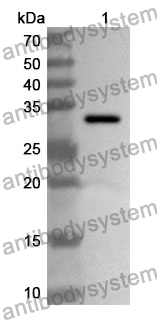Catalog No.
PMF72301
Species reactivity
Mouse
Host species
Rabbit
Isotype
IgG
Clonality
Polyclonal
Immunogen
E. coli - derived recombinant Mouse DEFB103A/DEFB3 (Phe21-Lys63).
Tested applications
ELISA: 1:4000-1:8000, IHC: 1:50-1:100, WB: 1:1000-1:4000
Target
Beta-defensin 3 (BD-3) (mBD-3) (Defensin, beta 3)
Purification
Purified by antigen affinity column.
Accession
Q9WTL0
Applications
ELISA, IHC, WB
Form
Liquid
Storage buffer
0.01M PBS, pH 7.4, 50% Glycerol, 0.05% Proclin 300.
Stability and Storage
Use a manual defrost freezer and avoid repeated freeze thaw cycles. Store at 2 to 8°C for frequent use. Store at -20 to -80°C for twelve months from the date of receipt.
Antimicrobial peptide gene expression in medication-related osteonecrosis of the jaw., PMID:33065485
Future trends in the treatment of atopic dermatitis., PMID:31204894
Differential Regulation of Mas-Related G Protein-Coupled Receptor X2-Mediated Mast Cell Degranulation by Antimicrobial Host Defense Peptides and Porphyromonas gingivalis Lipopolysaccharide., PMID:28694291
Human β-defensin-3 induces IL-8 release and apoptosis in airway smooth muscle cells., PMID:28437599
Human β-Defensin 3 Reduces TNF-α-Induced Inflammation and Monocyte Adhesion in Human Umbilical Vein Endothelial Cells., PMID:28348463
OmpA Binding Mediates the Effect of Antimicrobial Peptide LL-37 on Acinetobacter baumannii., PMID:26484669
Human β-defensin-3 increases the expression of interleukin-37 through CCR6 in human keratinocytes., PMID:25541254
Human β-defensin-3 promotes intestinal epithelial cell migration and reduces the development of necrotizing enterocolitis in a neonatal rat model., PMID:24956228
Infection of keratinocytes with Trichophytum rubrum induces epidermal growth factor-dependent RNase 7 and human beta-defensin-3 expression., PMID:24747887
Host defense (Antimicrobial) peptide, human β-defensin-3, improves the function of the epithelial tight-junction barrier in human keratinocytes., PMID:24633129
Keratinocyte growth factor phage model peptides can promote human oral mucosal epithelial cell proliferation., PMID:23313229
Membrane damage and repair in primary monocytes exposed to human β-defensin-3., PMID:22837529
Human β-defensin-3 alters, but does not inhibit, the binding of Porphyromonas gingivalis haemagglutinin B to the surface of human dendritic cells., PMID:22578747
The expression of β-defensin-2, 3 and LL-37 induced by Candida albicans phospholipomannan in human keratinocytes., PMID:21146963
Elevated levels of human beta-defensin 2 and human neutrophil peptides in systemic lupus erythematosus., PMID:20724351
History of eczema herpeticum is associated with the inability to induce human β-defensin (HBD)-2, HBD-3 and cathelicidin in the skin of patients with atopic dermatitis., PMID:20545685
Activation of TLR2 by a small molecule produced by Staphylococcus epidermidis increases antimicrobial defense against bacterial skin infections., PMID:20463690
Expression profile of human beta-defensin 3 in oral squamous cell carcinoma., PMID:19219676
Expression of human beta-defensin -1, -2, and -3 in non-inflamed pseudocyst, mucoceles., PMID:18627502
Defective killing of Staphylococcus aureus in atopic dermatitis is associated with reduced mobilization of human beta-defensin-3., PMID:18538383
Quantification of human beta-defensin-2 and -3 in body fluids: application for studies of innate immunity., PMID:17317882
Mechanism of HBD-3 deficiency in atopic dermatitis., PMID:17015038
Human beta-defensin-3 induction in H. pylori-infected gastric mucosal tissues., PMID:17007044

